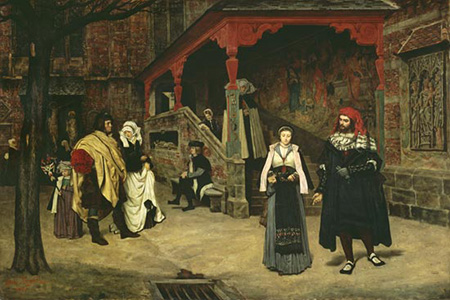
In Thomas Mann’s final, unfinished novel, “The Confessions of Felix Krull,” the young confidence-man protagonist — antihero is too strong a word — recounts that his father, an elderly roué, took great pleasure in merely reciting the words, les jolies femmes. I was repeatedly reminded of this deplorable but comical figure as I perused the glittering, splendidly painted depictions of haute bourgeois leisure in the San Francisco Legion of Honor’s current exhibition, “James Tissot: Fashion & Faith.”
Tissot (1836-1902), né Jacques Joseph Tissot, of the port city of Nantes, was the son of a wealthy drapery merchant. He decided as a teenager to forsake the family business, to his father’s chagrin. This defiance of paternal expectations, however, turned out well, as Tissot’s career took off immediately. His blending of classical realism and Romantic literary subject matter in “The Meeting of Faust and Marguerite” (1860), possibly influenced by the English Pre-Raphaelites, garnered the twenty-four-year-old artist a 5,000-franc purchase from the French government.
In the early 1860s Tissot abandoned historicizing imagery in favor of the depiction of his creative contemporaries — Baudelaire’s “heroism of modern life” — although his subject matter in portraits and semi-narrative paintings remained the wealthy upper-class patrons with whom he was socially and commercially connected. In 1871, he inexplicably (considering his conservative Catholic background) fought on the side of the Paris Commune; and when the rebels were exterminated by the government, he sensibly relocated to London (as some other leftist artists did), where his virtuosic paintings of exquisitely turned out jolies femmes, both French and English, found favor with British industrialists. In 1872, the thirty-something painter earned nearly 100,000 francs — the wages of a merchant prince of the day. Tissot knew the Impressionists; Degas painted his portrait. But he kept his distance from them professionally, as well as stylistically, for the most part. He did share their interest in Japanese culture, filling his large manorial home in London (located in bohemian St. John’s Wood) with exotic collectibles that found their way into his paintings, as did his lordly home and its grounds.
The Legion of Honor exhibition is well organized, presenting a clear picture of the artist’s development (though it’s curiously lacking in his voice), and beautifully presented. While a visual delight, it’s not an emotional one, despite the drama of Tissot losing his youthful muse, La Mystérieuse, Kathleen Newton, to tuberculosis (‘consumption’) and his subsequent embrace of séances and spiritualism in his sixties. Religious themes were imported into his paintings with mostly undistinguished results. If Robert Hughes once opined that Barnett Newman’s “Stations of the Cross” were no match for Titian’s, it’s fair to note that Tissot’s spooky illustrations of the Passion are no competition for Michelangelo or Piero della Francesca.
A few other qualifications are in order: Tissot’s drawing is sometimes off the mark, with disconnected body parts emerging from the extravagant costumery without evoking the body underneath. The effects sometimes verge on caricature, as in “Painters and Their Wives.” His restrained but knowing satires of the lower orders now look dated and elitist, as in “Provincial Woman,” “Too Early,” and “London Visitors.” The scenarios that he depicts are sometimes lacking in realistic space or lighting, looking as though they were assembled from various parts, without the rhythmic unity and grouping of the Renaissance painters like Carpaccio, an early influence. Check out “Departure of the Prodigal Son,” “Return of the Prodigal Son” and “Rue Royale”.
That said, Tissot’s apotheoses of young, attractive, wealthy women record Belle Époque Europe with the discerning eye of a tailor or seamstress. Possessing a master showman’s delight in painted spectacle paired with his extraordinary attention to detail was undoubtedly a compelling selling point for patrons used to hard-headed cost analysis. Several, such as “Safe to Win,” “The Fan,” “Young Women Looking at the Chinese Temple” and “Portrait of the Marquise de Miramon,” are stunning works of indisputable, irresistible charm and verve. Tissot’s more stagy, spiritualized and gauzy images tend toward kitsch.
The problem for a contemporary #MeToo audience, naturally, lies not in the aesthetic realm but the sociopolitical one. Tissot’s women are delicate, decorative creatures, however gloriously painted. It’s unfair to judge the past too harshly by present standards, something of a blood sport among Procrustean virtue-signalers these days, but the nineteenth-century status of women has to be considered in the case of Tissot. He was merely one of many artists engaged in the Male Gaze market. Peter Schjeldahl’s recent take in The New Yorker on Renoir expands on this. Bram Dijkstra in “Idols of Perversity: Fantasies of Feminine Evil in Fin-de-Siècle Culture” postulates that bourgeois women of that time, uneducated, confined and cosseted, were projected by their men as the repositories of Christian virtue and innocence. The dog-eat-dog world of relentless capitalist competition was the world from which they presumably offered these men relief. When they fell short of that unrealistic Hedda Gabler baby-woman pedestal, they were misogynistically transformed into the harpies, vampires and succubi of Symbolist art. These were the ancestresses of America’s castrating woman politicians running pedophile rings from pizza parlors. The truth is not always beautiful, nor is beauty always truthful: teachable moments for an audience addicted to glamor (etymologically speaking, a magic spell), sensationalist drama, and low-rent entertainment.’
